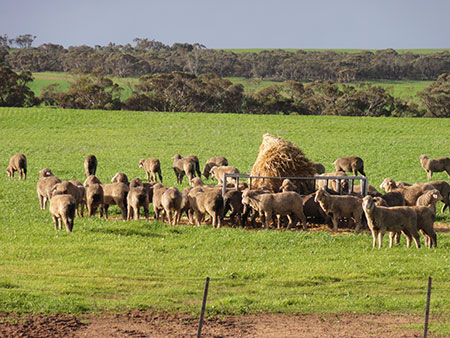Many properties tend to see a varying number of ewes ‘go down’ depending on the season. Even with attentive care many do not get up. Understanding the common reasons why late pregnant and early lactating ewes go down is important in reducing the number that may succumb.

Nutrition is critical to ewes.
The ewe, in a relatively short period of time, is expected to do a lot biologically, including eating enough to sustain herself and her foetus and/or fetuses (in late pregnancy with limited gut capacity), give birth, and then commence lactation, combined with intake and hormone fluctuations. The protein, energy and minerals being pulled from the ewe to enable her to perform these tasks are huge. The nutrition provided to her is crucial in not only surviving this period but ensuring that she, and her lambs, but thrive also.
Pregnancy toxaemia (also known as acetonemia or ketosis) is characterised by a reduced feed intake and a sweet smelling breath. Pregnancy toxemia results from not enough energy and the ewe compensating by rapidly breaking down body reserves. It often occurs in the final weeks of pregnancy due to the high nutritional demand on the ewe due to rapid fetal growth. It can occur in over fat ewes or undernourished ewes, often carrying multiple fetuses. It affects lamb health and survival, as well as the survival and productivity of the ewe. High quality diets in the final stages of pregnancy and priority feeding of ewes carrying multiple lambs (identified through pregnancy scanning) will help overcome the issue of reduced rumen volume and reduced intake capacity that ewes experience late in pregnancy. If you have shorn ewes lambing it must be noted that these ewes can utilise as much as 45% more energy to keep warm. This can compound the issue of pregnancy toxaemia and shelter is a must for these ewes. Periods of fasting resulting from yarding or trucking can also cause an onset of the disease.
Milk Fever or hypocalcemia can occur pre-lambing (due to the high amounts of calcium drawn from the ewe by the rapidly growing fetus), or in early lactation. The amount drawn from the ewe’s skeletal system depends on what she is consuming. Lush actively growing pastures, mature dry pastures and cereal grains used as supplementary feeds are all low in calcium. Sorrel and sour sob contain oxalates that bind up calcium. Excessive potassium found in molasses and some legumes or pastures fertilised with potash can also contribute to milk fever issues. Initially ewes stagger but most often they are found sitting with their head turned towards their flank, and most will die within 48 hours. Providing adequate calcium supplementation (where the base diet is low in calcium) and avoiding stressful situations with no feed, are crucial in prevention of this disease.
Hypomagnesamia also known as grass tetany or staggers is often seen in mature lactating ewes and results from a magnesium deficiency. There are no body reserves of magnesium readily available to animals so they are reliant on a constant supply from their diet, and a ewe has her highest demand for magnesium during lactation. As for milk fever, a high consumption of potassium will induce a magnesium deficiency. Grass dominant pastures or cereal crops, interruption to feeding, or a sudden onset of cold weather, are all associated with grass tetany. High protein pastures or high ammonia levels will also interfere with magnesium absorption. The most common cause of grass tetany is often inadequate feed; with ewes normally being found dead in the paddock. Ewes however may appear dull and have stopped eating, but if disturbed they may show nervous signs and have muscle tremors. Feeding hay which increases salivation or supplementing magnesium when the diet is low in magnesium is the best prevention. Using pasture analysis to understand the magnesium content of available feeds is a useful management strategy.
The three common disorders discussed are closely linked and any problems in your flock need to be investigated. Feed, blood, and/or liver sampling is an informative way in identifying accurately the metabolic issues your ewe flock might be facing. The correct supplementation can then be supplied. Mismanaging your ewes at this vulnerable time is a recipe for lost production and potentially high death rates. Consult your local vet or Animal Health Officer if you have any problems.
For further details contact Ian McFarland on 0437 659 353.